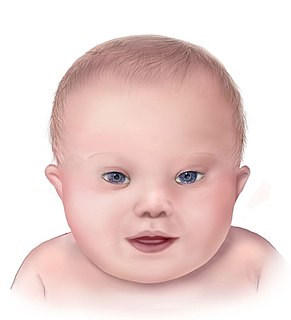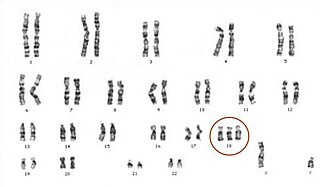
Raymond Alexander Turpin, born 5 November 1895 in Pontoise, died May 24, 1988, in Paris, was a French pediatrician and geneticist. In the late 1950s, his team discovered the chromosomal abnormality, trisomy 21, responsible for Down syndrome.

Raymond Alexander Turpin, born 5 November 1895 in Pontoise, died May 24, 1988, in Paris, was a French pediatrician and geneticist. In the late 1950s, his team discovered the chromosomal abnormality, trisomy 21, responsible for Down syndrome.
Turpin was admitted to the Faculty of Medicine of Paris in 1914, and in 1915 he was mobilized as a military medical assistant. Three years later, he was seriously affected by poison gas, and was subsequently awarded the Croix de Guerre. After the war, he resumed his medical studies, interning at Hôpitaux de Paris in 1921. As part of the Pasteur Institute, he participated, with Albert Calmette and Benjamin Weill-Hallé, in the first trials of the BCG vaccine, to prevent TB, and continued the collaboration until 1933. [1]
He also worked in pathology and pediatrics, including childhood tetany. In 1929, tetany was the topic of his medical thesis, for which he won the Thesis Prize of the Faculty of Medicine. In this work, he highlighted a specific electromyographic sign of tetany. After being named head of the laboratory and clinical director, he became Doctor of the Paris Hospitals in 1929.
From 1931, Turpin and his team researched Down syndrome. He studied the clinical presentation of the disease in affected individuals, their ancestors, descendants and siblings. In 1937, he wrote: "The assumption that mongolism is connected with a chromosomal abnormality is acceptable (...) like the Bar mutation, due to a chromosomal abnormality in the (fly) drosophila." [2] In 1956, several teams established that the number of human chromosomes is 46, [3] and it became possible to count the number of chromosomes in a sample in the laboratory.
From 1956 to 1958, Turpin - with students Jérôme Lejeune and Marthe Gautier - studied the number and appearance of chromosomes in the cells of children with and without Down syndrome, and in 1958 they found that children with Down syndrome possess 47 chromosomes: they carry three copies (trisomy) of one chromosome instead of the usual two (disomy). This chromosome was designated chromosome 21 in 1960. [4]
Turpin discovered, in 1959, the first structural chromosomal abnormality translocation, the second of the two main types of chromosomal abnormalities.
In 1947, Turpin founded the French Genetics Society, of which he became president in 1954. He was appointed professor at the Faculty of Medicine of Paris, first in therapeutics (1947-1956), and then in infant health and medicine. He was elected president of the French Society of Pediatrics in 1960 and participated in the creation of the first chair of genetics in 1965 which was initially entrusted to Jérôme Lejeune. He was also elected member of the French Academy of Sciences, Académie Nationale de Médecine and the Académie nationale de pharmacie.

Down syndrome or Down's syndrome, also known as trisomy 21, is a genetic disorder caused by the presence of all or part of a third copy of chromosome 21. It is usually associated with physical growth delays, mild to moderate intellectual disability, and characteristic facial features. The average IQ of a young adult with Down syndrome is 50, equivalent to the mental ability of an eight- or nine-year-old child, but this can vary widely.

Cytogenetics is essentially a branch of genetics, but is also a part of cell biology/cytology, that is concerned with how the chromosomes relate to cell behaviour, particularly to their behaviour during mitosis and meiosis. Techniques used include karyotyping, analysis of G-banded chromosomes, other cytogenetic banding techniques, as well as molecular cytogenetics such as fluorescent in situ hybridization (FISH) and comparative genomic hybridization (CGH).
Patau syndrome is a syndrome caused by a chromosomal abnormality, in which some or all of the cells of the body contain extra genetic material from chromosome 13. The extra genetic material disrupts normal development, causing multiple and complex organ defects.

Edwards syndrome, also known as trisomy 18, is a genetic disorder caused by the presence of a third copy of all or part of chromosome 18. Many parts of the body are affected. Babies are often born small and have heart defects. Other features include a small head, small jaw, clenched fists with overlapping fingers, and severe intellectual disability.
Irene Ayako Uchida, was a Canadian scientist and Down syndrome researcher.
The year 1958 in science and technology involved some significant events, listed below.
Prenatal testing consists of prenatal screening and prenatal diagnosis, which are aspects of prenatal care that focus on detecting problems with the pregnancy as early as possible. These may be anatomic and physiologic problems with the health of the zygote, embryo, or fetus, either before gestation even starts or as early in gestation as practicable. Screening can detect problems such as neural tube defects, chromosome abnormalities, and gene mutations that would lead to genetic disorders and birth defects, such as spina bifida, cleft palate, Down syndrome, Tay–Sachs disease, sickle cell anemia, thalassemia, cystic fibrosis, muscular dystrophy, and fragile X syndrome. Some tests are designed to discover problems which primarily affect the health of the mother, such as PAPP-A to detect pre-eclampsia or glucose tolerance tests to diagnose gestational diabetes. Screening can also detect anatomical defects such as hydrocephalus, anencephaly, heart defects, and amniotic band syndrome.

Cri du chat syndrome is a rare genetic disorder due to a partial chromosome deletion on chromosome 5. Its name is a French term referring to the characteristic cat-like cry of affected children. It was first described by Jérôme Lejeune in 1963. The condition affects an estimated 1 in 50,000 live births across all ethnicities and is more common in females by a 4:3 ratio.

Jérôme Jean Louis Marie Lejeune was a French pediatrician and geneticist, best known for discovering the link of diseases to chromosome abnormalities and for his subsequent opposition to prenatal diagnosis and abortion. He is venerated in the Catholic Church, having been declared Venerable by Pope Francis on 21 January 2021.

Guido Fanconi was a Swiss pediatrician. He was born in Poschiavo, a small village in the Canton of Grisons. Fanconi is regarded as one of the founders of modern pediatrics.

The palpebral fissure is the elliptic space between the medial and lateral canthi of the two open eyelids. In simple terms, it is the opening between the eyelids. In adult humans, this measures about 10 mm vertically and 30 mm horizontally.
A chromosomale abnormality, chromosomal anomaly, chromosomal aberration, chromosomal mutation, or chromosomal disorder, is a missing, extra, or irregular portion of chromosomal DNA. These can occur in the form of numerical abnormalities, where there is an atypical number of chromosomes, or as structural abnormalities, where one or more individual chromosomes are altered. Chromosome mutation was formerly used in a strict sense to mean a change in a chromosomal segment, involving more than one gene. Chromosome anomalies usually occur when there is an error in cell division following meiosis or mitosis. Chromosome abnormalities may be detected or confirmed by comparing an individual's karyotype, or full set of chromosomes, to a typical karyotype for the species via genetic testing.
Patricia Ann Jacobs OBE FRSE FRS FMedSci FRCPath is a Scottish geneticist and is Honorary Professor of Human Genetics, Co-director of Research, Wessex Regional Genetics Laboratory, within the University of Southampton.
Amin J. Barakat is a Lebanese-American physician known for the diagnosis Barakat syndrome.
Potocki–Lupski syndrome (PTLS), also known as dup(17)p11.2p11.2 syndrome, trisomy 17p11.2 or duplication 17p11.2 syndrome, is a contiguous gene syndrome involving the microduplication of band 11.2 on the short arm of human chromosome 17 (17p11.2). The duplication was first described as a case study in 1996. In 2000, the first study of the disease was released, and in 2007, enough patients had been gathered to complete a comprehensive study and give it a detailed clinical description. PTLS is named for two researchers involved in the latter phases, Drs. Lorraine Potocki and James R. Lupski of Baylor College of Medicine.
Marthe Gautier is a French medical doctor and researcher, best known for her role in discovering the link of diseases to chromosome abnormalities.

Eeva Maria Therman-Patau (1916–2004) was a Finnish-born American geneticist. She worked to characterize the effects and cytogenetics of trisomy 13 and trisomy 18, two rare and usually fatal genetic disorders caused by an extra copy of chromosome 13 and 18, respectively. Her works include Human Chromosomes: Structure, Behavior, Effects, a textbook on cytogenetics which is in its 4th edition. Her research specialties included X-inactivation in mammals and chromosomal abnormalities in cancer.

Tetrasomy X, also known as 48,XXXX, is a chromosomal disorder in which a female has four, rather than two, copies of the X chromosome. It is associated with intellectual disability of varying severity, characteristic "coarse" facial features, heart defects, and skeletal anomalies such as increased height, clinodactyly, and radioulnar synostosis. Tetrasomy X is a rare condition, with few medically recognized cases; it is estimated to occur in approximately 1 in 50,000 females.

Pentasomy X, also known as 49,XXXXX, is a chromosomal disorder in which a female has five, rather than two, copies of the X chromosome. Pentasomy X is associated with short stature, intellectual disability, characteristic facial features, heart defects, skeletal anomalies, and pubertal and reproductive abnormalities. The condition is exceptionally rare, with an estimated prevalence between 1 in 85,000 and 1 in 250,000.

Trisomy X, also known as triple X syndrome and characterized by the karyotype 47,XXX, is a chromosome disorder in which a female has an extra copy of the X chromosome. It is relatively common and occurs in 1 in 1,000 women but it is rarely diagnosed; fewer than 10% of those with the condition know they have it.